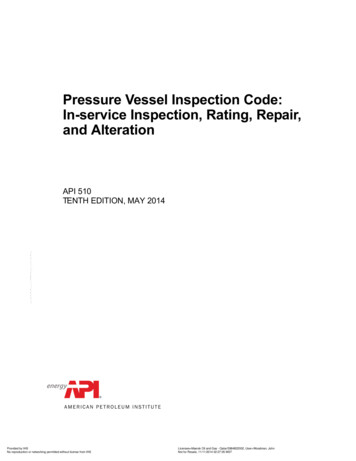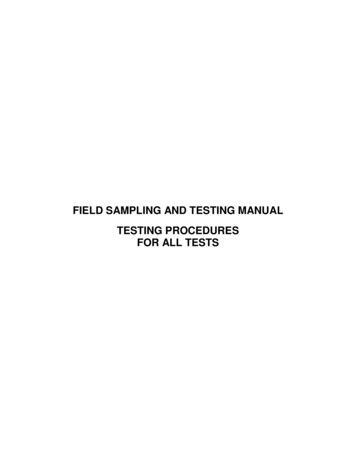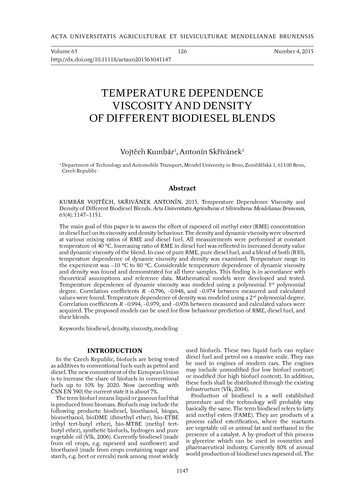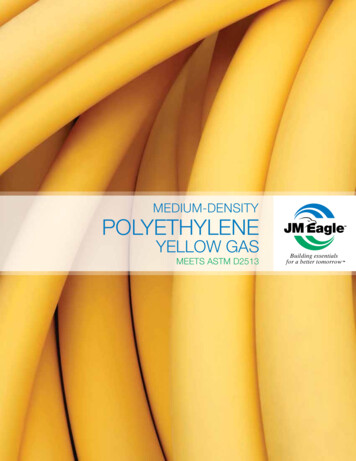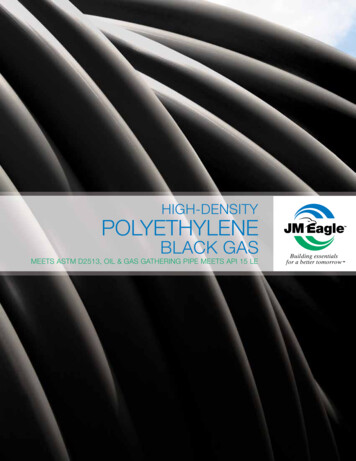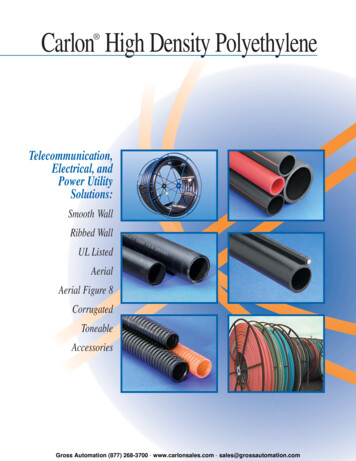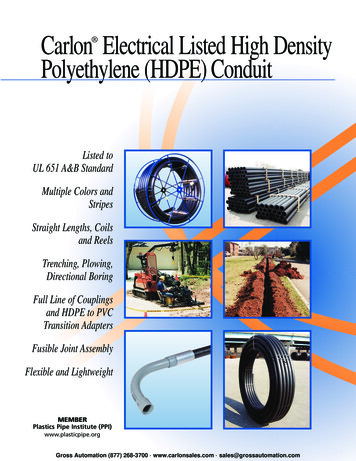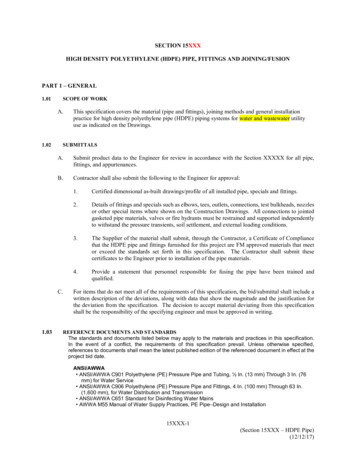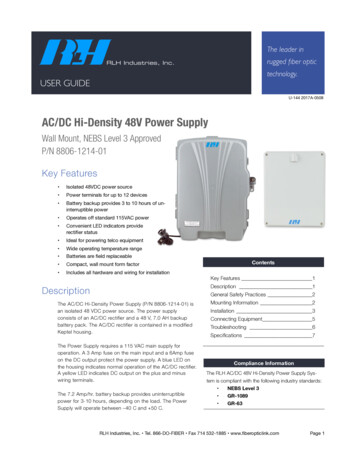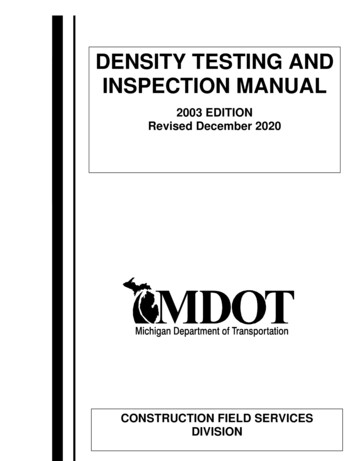
Transcription
DENSITY TESTING ANDINSPECTION MANUAL2003 EDITIONRevised December 2020CONSTRUCTION FIELD SERVICESDIVISION
FOREWORDThis manual provides guidance to administrative, engineering, and technical staff. Engineeringpractice requires that professionals use a combination of technical skills and judgment indecision making. Engineering judgment is necessary to allow decisions to account for uniquesite-specific conditions and considerations to provide high quality products, within budget, andto protect the public health, safety, and welfare. This manual provides the general operationalguidelines; however, it is understood that adaptation, adjustments, and deviations aresometimes necessary. Innovation is a key foundational element to advance the state ofengineering practice and develop more effective and efficient engineering solutions andmaterials. As such, it is essential that our engineering manuals provide a vehicle to promote,pilot, or implement technologies or practices that provide efficiencies and quality products, whilemaintaining the safety, health, and welfare of the public. It is expected when making significantor impactful deviations from the technical information from these guidance materials, thatreasonable consultations with experts, technical committees, and/or policy setting bodies occurprior to actions within the timeframes allowed. It is also expected that these consultations willeliminate any potential conflicts of interest, perceived or otherwise. MDOT Leadership iscommitted to a culture of innovation to optimize engineering solutions.The National Society of Professional Engineers Code of Ethics for Engineering is founded on sixfundamental canons. Those canons are provided below.Engineers, in the fulfillment of their professional duties, shall:1.2.3.4.5.6.Hold paramount the safety, health, and welfare of the public.Perform Services only in areas of their competence.Issue public statement only in an objective and truthful manner.Act for each employer or client as faithful agents or trustees.Avoid deceptive acts.Conduct themselves honorably, reasonably, ethically and lawfully so as to enhance thehonor, reputation, and usefulness of the profession.This manual has been prepared to document procedures used by the Michigan Department ofTransportation (MDOT) to assure quality in density testing and inspection in the field. It reflectscurrent Michigan Department of Transportation practice, as based on past experience and onrecognized national standards in testing procedures. This manual is written to serve as aprocedures manual and training aid for technicians performing density testing on MDOT projects.Technician qualification requirements are documented in accordance with 23 CFR 637.Furthermore, this manual is part of MDOT’s Materials Quality Assurance Program.Inquiries concerning the information presented in this manual may be directed to:MDOT Density Technology UnitP.O. Box 30049Lansing, MI 48909(517) 636-4970Copies of the Density Testing and Inspection Manual can be obtained from:MDOT Engineering Prints Office7575 Crowner DriveDimondale, MI 48821(517) 636-0650
MDOT Density Testing and Inspection Manual2003 Ed., Rev. Dec. 2020TABLE OF CONTENTSI.DENSITY TESTS AND METHODSA. INTRODUCTION1. Soils. 12. Hot Mix Asphalt (HMA) Mixtures . 13. Stabilized Mixtures . 14. Pulverized Pavement Mixtures . 25. Density . 26. Compaction . 27. The Density Test . 28. Controlled Density Method . 39. The Twelve-Inch Layer Method . 310. Equipment . 411. Personal Protective Equipment (PPE) . 10B. DENSITY TESTS1. THE ONE-POINT T-99 TESTa. Description . 11b. Preparing and Compacting the Sample . 11c. Weighing the Sample . 14d. Moisture Determination . 15e. Determining Maximum Density and Optimum Moisture . 15f. Precautions in Performing the One-Point T-99 Test . 172. THE AASHTO T-99 TESTa. Description . 19b. Preparing and Compacting the Sample . 19c. Weighing the Sample . 20d. Completing the Test Procedure . 20e. Completing the Full Test Curve . 20f. Determining Maximum Density and Optimum Moisture . 21g. Precautions in Performing the AASHTO T-99 Test . 213. THE ONE-POINT MICHIGAN CONE TESTa. Description . 22b. Preparing, Compacting and Weighing the Sample (Sand or Gravel) . 22c. Determining Moisture Content (Sand or Gravel) . 27d. Determining Maximum Density and Optimum Moisture . 27e. Precautions in Performing the One-Point Michigan Cone Test . 294. THE MICHIGAN CONE TESTa. Description . 30b. Preparing, Compacting and Weighing the Sample (Sand or Gravel) . 30c. Determining Moisture Content (Sand or Gravel) . 31d. Determining Maximum Density of Granular Soil other than Processedii
MDOT Density Testing and Inspection Manual2003 Ed., Rev. Dec. 2020Aggregates . 31e. Determining Maximum Density of Aggregate Base Courses and SurfaceAggregates . 31f. Precautions in Performing the Michigan Cone Test. 325. THE MICHIGAN MODIFIED T-180 TESTa. Description . 32b. Obtaining and Compacting the Sample. 33c. Weighing the Sample . 35d. Determining Wet Maximum Density . 36e. Precautions in Performing the Michigan Modified T-180 Test . 386. THE DENSITY IN-PLACE (NUCLEAR) TESTa. Description . 38b. Location and Frequency of Test . 39c. Troxler Model 3440 . 391) Keys Description . 412) 3440 Keypad Layout . 413) Turning the Gauge On . 424) Recharging the Batteries . 435) Taking the Standard Counts . 436) Viewing the Last Four Standard Counts. 457) Setting Measurement Units . 458) Count Time Selection . 469) Mode Selection . 47a) Soils Mode Selection . 47b) Asphalt Mode Selection . 4710) Density/Moisture Measurement . 48a) Soils Mode . 48b) Asphalt Mode . 4911) Proctor (Cone) / Marshall / Voidless Function. 50a) Recall a Stored Proctor (Cone) / Marshall Value . 51b) Enter a New Proctor (Cone) / Marshall Value . 5112) Recall Function . 5213) Depth Function . 52a) Manual Mode . 52b) Automatic Mode . 53d. Precautions in Performing the Density In-Place (Nuclear) Test . 54e. Care of Nuclear Gauge and Equipment . 547. CALCIUM CARBIDE GAS PRESSURE METER (“SPEEDY” MOISTURE TESTER)a. Description . 56b. Care of the Pressure Meter . 56c. Use of the Pressure Meter . 59d. Test Procedure for Sand and Gravel (Loss-by-Washing of 15 Percent or Less) 61e. Test Procedure for Cohesive Soil (Half Sample [10 gram or 13 gram],Proportional Method or Loss-By-Washing Greater than 15 Percent) . 65f. Precautions in Performing Moisture Tests with the Calcium Carbide GasPressure Meter (“Speedy”) . 68g. Determining Moisture Content of the Sample by the Stove Method. 68iii
MDOT Density Testing and Inspection Manual2003 Ed., Rev. Dec. 20208. REPORTS AND RECORDSa. General . 68b. Precautions for Records and Reports . 74C. DENSITY TESTING METHODS1. THE CONTROLLED DENSITY METHODa. Description . 74b. Moisture Content. 75c. Placement and Compaction of Material . 762. THE TWELVE-INCH LAYER METHODa. Description . 77b. Obtaining, Preparing, Compacting and Weighing the Sample . 77c. Determining Moisture Content . 77d. Determining Maximum Density. 77e. Precautions in Performing the Twelve-Inch Layer Method . 78II. TECHNICIAN QUALIFICATION PROGRAM FOR FIELD DENSITY TESTINGA. Technician Qualifications . 79B. Maintaining Records . 79C. Disqualification of Technicians . 80III. APPENDIXA. DEFINITIONS . 81B. CHECKLIST FOR THE ONE-POINT T-99 TEST . 85C. CHECKLIST FOR THE AASHTO T-99 TEST .
AASHTO definition gravel will pass the 3 inch sieve and be retained on the No. 10 sieve. Cobbles and boulders are larger rocks which may also be present in soils. For the purpose of this manual, the term “soil” refers to mixtures of soil, air and water.
